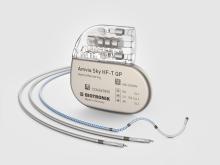Managing AF Transforming AF Management: Less Work, Improved Outcomes with Home Monitoring
For Atrial Fibrillation (AF) Awareness Month, we’re spotlighting early detection and continuous monitoring technologies that enable effective, forward-thinking AF management. While symptomatic episodes often bring patients to clinical attention, it’s the asymptomatic or subclinical AF episodes that frequently go unnoticed. Individuals with AF have four times the risk of heart failure as individuals without AF, and approximately 10-40% of AF patients remain asymptomatic or undiagnosed, even in developed countries.[i]
This is where remote monitoring technology, such as BIOTRONIK Home Monitoring, can transform a doctor’s toolkit, enabling proactive, data-driven AF detection and management. As the central hub for automatic data transmission from BIOTRONIK devices, the Home Monitoring system reduces manual burden, saves time for doctors, and improves patient outcomes.

Seamless Data Flow: How Home Monitoring Streamlines AF Management
BIOTRONIK Home Monitoring is an automatic, wireless system that transmits diagnostic and device data daily from a patient’s implanted cardiac device to a secure online platform: the Home Monitoring Service Center (HMSC).
Here’s how it works:
- Every night, while the patient sleeps, their device automatically transmits cardiac data
- The CardioMessenger, placed next to their bed, receives the data and passes it on to a secure server
- The server safely stores all data according to the latest security regulations
- Physicians log into the protected website to view data
- Physicians can program alerts to enable them to take timely, well-informed action
Once a patient is set up with the CardioMessenger, data transmission occurs without any patient interaction, ensuring consistent data flow and enabling physicians to monitor patients remotely and identify clinically relevant events earlier than with traditional in-office follow-ups.
Designed with efficiency and clinical value in mind, the system sends daily updates and triggers alerts when pre-defined thresholds are met, such as the detection of a long atrial episode or a three-day lack of data transmission. This alert-based workflow helps medical staff triage and prioritize patients who need immediate attention while reducing unnecessary in-person visits, thereby reducing workload. Data integration with EHR systems and customizable reports further streamlines follow-up, supporting timely, individualized AF management and aligning with current guideline-based care pathways.
The BIOTRONIK Patient App further enhances the value of Home Monitoring by providing physicians with additional, context-rich data to support clinical decision-making. Patients can easily log their symptoms, which are then sent to the HMSC for evaluation. This enables more accurate symptom-rhythm correlation, helping physicians assess AF burden, evaluate treatment effectiveness, and tailor follow-up strategies.
BIOTRONIK Home Monitoring is not only clinically effective but also popular with patients. In a multicenter study, 99% of participants rated the system as easy to use, and 98% expressed complete satisfaction with the technology.[i] Because data transmission occurs automatically—without requiring any patient interaction—the system ensures a high level of reliability, evidenced by 98% data transmission success.[ii] For physicians, this means confidence that clinically relevant device data is consistently delivered, without placing additional burden on patients, ultimately supporting both patient comfort and clinical efficiency.
Data Shows: Earlier Detection, Improved Outcomes, & Reduced Clinical Burden
Home Monitoring has been proven to support earlier detection of AF for ICD patients. The TRUST clinical trial evaluated the efficacy and safety of automatic remote monitoring for patients with ICDs, and found that it delivered a significant gain in early detection of clinically relevant symptomatic and asymptomatic events. Early detection is critical in AF management, especially for preventing stroke and initiating timely treatment. Patients using Home Monitoring required 45% fewer in-office visits[iii], demonstrating that remote follow-up is not only safe but also reduces the burden on both patients and physicians.
A later study, “Alert-Based ICD Follow-Up: A Model of Digitally Driven Remote Patient Monitoring,” confirmed that Home Monitoring reduces clinical burden and supports earlier detection. It found that modern alert-driven remote patient monitoring makes follow-up more efficient and targeted, reducing non-actionable visits by 81%.[iv] This significant drop in non-actionable visits frees up staff time and clinic capacity.
Reliable and Secure Data
Reliability and data security are central to BIOTRONIK Home Monitoring. All transmissions are handled through a state-of-the-art data center in Germany, operating under some of the world’s strictest data protection regulations. The system is certified to international information security standards (ISO / IEC 27001: 2017 Standard) and designed to be fully compliant with GDPR, ensuring that sensitive health data remains secure at every step.
At its core, Home Monitoring is about enabling physicians to provide better care for patients while reducing the unnecessary burden on healthcare teams. It ensures that every decision is informed by timely, high-quality data—helping prevent complications, improving outcomes, and freeing clinical capacity for what matters most. With proven impact, reliability, and forward-thinking design, BIOTRONIK Home Monitoring sets a new standard for AF management.
With BIOTRONIK Home Monitoring, AF can be detected earlier, managed more effectively, and treated with the timely precision that truly changes patients’ lives. Read more about our unique AF management solutions in our blog series for AF Awareness month.
[i] Kultaratna et al. Global, regional and national burden of heart failure associated with atrial fibrillation, MC Cardiovascular Disorders (2023) 23:345 https://doi.org/10.1186/s12872-023-03375-9
[ii] Ricci R P et al. HoMASQ Study, Europace. 2010, 12(5).
[iii] Mariani JA, Weerasooriya R, van den Brink O, Mohamed U, Gould PA, Pathak RK, Lin T, Conradie A, Illes P, Pavia S, Rajamani K, Lovibond S, Matthews I, DiFiore D, Arumugam D, Schrader J, Lau DH. Miniaturized implantable cardiac monitor with a long sensing vector (BIOMONITOR III): Insertion procedure assessment, sensing performance, and home monitoring transmission success. J Electrocardiol. 2020 May-Jun;60:118-125. doi: 10.1016/j.jelectrocard.2020.04.004. Epub 2020 Apr 11. PMID: 32361086.
[iv] Varma N et al. Efficacy and Safety of Automatic Remote Monitoring for Implantable Cardioverter-Defibrillator Follow-Up: The Lumos-T Safely Reduces Routine Office Device Follow-Up (TRUST) Trial. Circulation. 2010;122:325 – 332.
[v] Varma N et al. Alert-Based ICD Follow-Up. JACC: Clinical Electrophysiology. 2021;76 (Suppl 1):1363. doi: 10.1016/j.jacep.2021.01.008.




